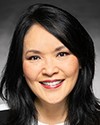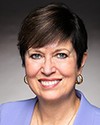Thank you, Madam Chair and members of the committee, for this opportunity.
The Women Unlimited Association is a not-for-profit organization in Nova Scotia that supports diverse women to build careers in the trades and technology fields. Cited as a best practice in Canada, we work with relevant industries, unions, governments, apprenticeship, educational institutions, and the community to address the systemic barriers diverse women face and to support their recruitment, retention, and advancement in the trades and technology fields.
Women Unlimited works with women like Denise Watters, who we'll hear from shortly this morning, who are dedicated to building careers in the skilled trades. Although women represent 50% of the workforce, they make up only 5% of our skilled trades workers. Trades jobs offer women a living wage with benefits. We know that when you improve a women's economic situation, there's a ripple effect that spreads to her children, her family, and her community. Women's economic prosperity is a gift that keeps on giving.
Our model is designed to encourage and support diverse women along a multi-year journey from recruitment to career exploration, through college level trades and technology training, to employment, and along the apprenticeship pathway to certification. Women are with us for between three and seven years, some 10.
Since 2006, we have supported more than 650 diverse women to build careers in these fields. To date, 94% have completed our programs. More than 80% have proceeded to college level training and on to employment, many of them at the top of their class, I might add.
A recruitment process sets diversity goals. As a result, 50% of those selected self-identify as African Nova Scotian, indigenous women, immigrant women, women living with disabilities, and women from the LGBTQ community. As well, more than 65% are youth, and almost 50%—47% to be exact—are lone parents. I'm also proud to say that 75% of our dedicated professional staff self-identify as diverse, thus creating a culture wherein diversity can thrive.
More than 175 Nova Scotian employers have hired our graduates, employers such as Irving Shipbuilding, through the national shipbuilding procurement strategy, and Emera Newfoundland and Labrador, through the Maritime link project. They have significant partnerships with Women Unlimited to increase gender diversity in their workplaces.
Through complex consortiums and partnerships, Women Unlimited has demonstrated what can be accomplished when resources and commitments are combined to achieve the common goal of addressing the systemic barriers diverse women face and supporting their successful recruitment, retention, and advancement in these fields. The greatest barrier diverse women face is finding employers who are not only willing to hire them but also committed to supporting them through the apprenticeship journey to certification and to addressing the workplace culture in a comprehensive, sustainable way.
Women Unlimited's partnership with Irving Shipbuilding is a good example of what an effective consortium can achieve. In 2011, when Irving Shipbuilding was awarded the combat vessel package under the national shipbuilding strategy, Women Unlimited saw it as an opportunity to increase the number of women working in the trades at the Halifax shipyard. Within a year, Irving Shipbuilding began a partnership with the Nova Scotia Community College called Irving Shipbuilding's centre of excellence.
Irving committed to invest $250,000 annually over the life of the contract to create opportunities for Nova Scotians to participate in shipbuilding, with a specific focus on under-represented groups: women, African Nova Scotians, indigenous persons, and persons with disabilities. Women represented only 3.7% of Irving Shipbuilding's trades workforce, so this investment could change that. We had a vehicle.
The Irving Shipbuilding-Women Unlimited partnership was launched in April 2015. Twenty diverse women were recruited through a joint selection process with Women Unlimited and Irving. With the support of the Government of Nova Scotia, they participated in a 14-week career exploration program focused on the metal trades. The following year they entered college-level welding and metal fabrication programs with a letter of intent to hire from Irving. With the support from the Canadian Women's Foundation, Women Unlimited provided wraparound support so that challenges associated with child care, transportation, driver education, books, tools, and tutoring were addressed.
With the support of Status of Women Canada, Women Unlimited is working with Irving Shipbuilding and others in the marine sector, including the Nova Scotia Boatbuilders Association, to build gender equity strategies to support both their retention and advancement in these fields. Advancement in a skilled trade also depends on achieving a Red Seal certification. It is the other post-secondary venue.
Status of Women Canada is also supporting Women Unlimited to work with our industry and apprenticeship partners to build a more inclusive and respectful apprenticeship system for diverse women. We will be building a gender equity plan, a women-in-trades network, and participating in the pan-Canadian network of women leaders.
The Irving Shipbuilding-Women Unlimited partnership is ground-breaking. Why?
First, this national contract had requirements for diversity hiring. As a result we built an intentional coalition between more than eight diverse partners—Irving Shipbuilding, Unifor, Women Unlimited, the Nova Scotia Community College, the governments of both Nova Scotia and Canada, the Nova Scotia Apprenticeship Agency, the Canadian Welding Association Foundation, and Praxair Canada—through a vehicle called the Irving Shipbuilding centre of excellence.
Second, we have demonstrated excellence in women-centred programming through a model of best practice. Third, we are working to shift the workplace and apprenticeship culture. Fourth, we are broadening our impact. Irving Shipbuilding has committed to two more projects with Women Unlimited. The second group started this April, in 2017, and the third will be in 2019.
These are my recommendations.
I recommend that the Government of Canada establish procurement and employment agreements on all infrastructure funding proposals requiring diversity plans with a goal of achieving employment equity and gender diversity in the trades. Second, we recommend that the Government of Canada establish a five-year national funding strategy to support the full and equitable participation of diverse women in apprenticeship in the skilled trades.
Thank you.








